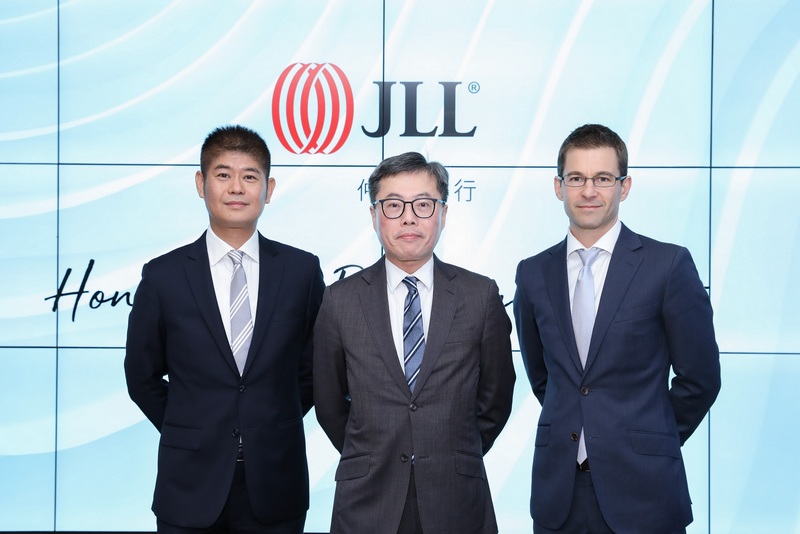(12 December 2019, Hong Kong) The longest bull market in Hong Kong’s property market history has come to an end in the second half of this year due to the local social movement and economic uncertainties. Prices and rents of office, high street shops and residential properties are expected to drop 10% to 20% in 2020, according to JLL’s Year-end Property Market Review and Forecasts published today. Capital values of prime industrial properties, however, will only drop 5% to 10% on the back of industrial revitalisation opportunities and tight vacancy.

Terence Chan(Left to right), Joseph Tsang, Alex Barnes
Highlights of the report:
- Net take-up of Grade A office has decreased 62% to just under 1.1 million sq ft in 2019.
- Central rents plunged 6.3% in the second half of the year, the sharpest decline among the business districts as PRC demand curbed.
- Grade A office rents will fall 15-20% next year as vacancy rates will continue to rise on the back of weak demand.
- Rents of high street shops and prime shopping malls dropped 18.4% and 5.6% respectively this year.
- High street shop rents will plunge 15-20% next year, but rents in prime shopping centres will drop about 5% only.
- Capital values of luxury residential dropped 4.7% since July, reversing the growth achieved in the first half of this year.
- The economic slowdown in mainland China and Hong Kong will dampen housing demand, particularly in the luxury residential market that relies on PRC demand. Capital values of luxury residential will drop about 20% in 2020.
- Developers will face increasing pressure in pricing in order to offload stocks due to the introduction of vacancy tax and the increase in housing supply. Prices of mass residential are expected to drop 10-15% next year.
Office market
Hong Kong’s Grade A office market has entered a downward cycle due to the US-China trade war and the local political uncertainties. Net take-up of Grade A office has decreased 62% to just under 1.1 million sq ft in 2019. Demand was subdued as a number of tenants have withdrawn expansion plans, while the demand from PRC firms (in Central) and co-working operators have also decreased this year by 34% and 26% respectively, from stronger 2018 demand. New lettings in the overall market have dropped by 31% so far this year as compared to 2018.
As a result, the overall market’s vacancy rate has reached 5.9%, the highest point since April 2010. Coupled with the returning space from decentralising tenants, the vacancy rate in Central raised to 3.5%, the highest in more than 4 years.
Overall Grade A office rents has dropped 3.4% so far this year. Central rents plunged 6.3% in the second half after rising by 1.0% in the first half. The submarket recorded the sharpest decline among all business districts as PRC demand curbed.
Alex Barnes, Head of Markets at JLL in Hong Kong, said: “Decentralisation for more cost-effective options will remain a key trend next year as tenants control real estate costs during uncertain times. Leasing demand is expected to remain moderate in 2020. We forecast Grade A office rents to fall 15-20% next year as vacancy rates will continue to rise. Central will experience the greatest downward pressure as there is a significant rental gap between Central and other office submarkets.”
Hong Kong Prime Office Indicator – % Change
| Submarket | Rents*
(2019) |
2020 Rental Forecast |
| Central | ▼5.4% | ▼15-20% |
| Wanchai/Causeway Bay | ▼3.6% | ▼15-20% |
| Hong Kong East | ▲3.5% | ▼5-10% |
| Tsimshatsui | ▲0.2% | ▼15-20% |
| Kowloon East | ▼1.9% | ▼10-15% |
| Overall | ▼3.4% | ▼15-20% |
*Preliminary
Retail Market
The inbound tourism market was hit hard in the second half, with total arrivals down 23.8% y-o-y between June and October. Overall retail sales in the third quarter dropped 17.5% y-o-y, the sharpest quarterly decline in more than two decades. Sales of tourist-driven retailers such as jewellery and watches, cosmetics and clothing dropped the most.
Business in the traditional shopping districts and certain shopping centres were severely disrupted, which led the rents of high street shops and prime shopping malls to fall by 18.4% and 5.6% respectively this year. Meanwhile, retailers are more willing to explore opportunities in the residential areas.
Leasing demand is now mainly coming from mass-market lifestyle retailers and F&B operators who newly entered the market. There are also more pop-up stores and short-term leases taking place as landlords are eager to fill the space before the holiday seasons.
Terence Chan, senior director of retail at JLL in Hong Kong, said: “Leasing demand will be limited in 2020 as the global and local economies remain uncertain. We expect the high street shop rents will plunge 15-20% next year. However, rents in prime shopping centres will drop only about 5% as new market entrants still prefer to enter prime shopping centres.”
Hong Kong Prime Retail Indicator – % Change
| Sector | Rent
(2019)* |
2020 Rental Forecast |
| High Street Shops | ▼18.4% | ▼15-20% |
| Prime Shopping Centres | ▼5.6% | ▼~5% |
*Preliminary
Residential Market
Capital values of mass and luxury residential slipped in the second half of 2019, on the back of weakening market sentiment. Mass residential showed more resilience on prices, supported by strong pent-up demand and relaxation in mortgage rules.
Luxury residential market was largely backed by PRC capital over the past five to ten years. However, PRC buyers turned inactive this year due to the tightened capital outflow policy and the US-China trade war. Capital values of luxury residential dropped 4.7% since July, reversing the growth achieved in the first half of this year.
The unemployment rate started to rise and reached 3.1% during August to October 2019. Given a strong reverse relationship between unemployment and housing prices from historical trends, the rising unemployment rate will weigh on the housing market.
Hong Kong has experienced three property crashes since 1997. Property prices plunged 50% in a year due to the Asian financial crisis and dropped a further of 43% during the dot.com bubble and SARS outbreak period, with the last downfall of 24% taking place in 2008 during the global financial crisis.

Joseph Tsang
Joseph Tsang, Chairman and Head of Capital Markets at JLL in Hong Kong, said: “Capital values of mass residential dropped 2.5% in the second half of the year due to the local political situation. We believe the market sentiment will remain tied to social tensions in 2020. The economic slowdown in mainland China and Hong Kong will dampen housing demand, particularly in the luxury residential market that relies on PRC demand. Capital values of luxury residential will drop about 20% in 2020. Developers will face increasing pressure in pricing in order to offload stock due to the introduction of the vacancy tax and the increase in housing supply. Prices of mass residential is expected to drop 10-15% next year.”
Hong Kong Residential Indicator – % Change
| Sector | Capital Values
(2019)* |
2020 Capital Values Forecast |
| Mass Residential | ▲1.3% | ▼10-15% |
| Luxury Residential | ▼1.0% | ▼~20% |
*Preliminary
Investment Market
The tug of war between investors and vendors in addition to fewer PRC buyers in the market have led investment volumes for commercial properties priced over HKD 20 million falling significantly to HKD13.6 billion in the second half of 2019, the lowest half yearly result in 11 years.
The recent social movement has significantly impacted on the retail sector. Sales of retail properties dropped 67% y-o-y to HKD15.9 billion in 2019 amid the lack of large portfolio transactions, the sharpest fall among all property sectors. Capital values of high street shops plunged 18.8% since June.
Capital values of warehouse and flatted factories stayed relatively firm on the back of industrial revitalization opportunities and limited future supply over the medium term.
The high proportion of PRC investment volumes has contributed to the surge of Grade A office capital values over the last five years. However, only 14% of total investment volume in the office market this year was from PRC funds, compared to 35% recorded in 2018. It is also the lowest contribution since 2014.
Joseph said: “Capital values will drop more than rents as buyers would look for higher returns with the increased vacancy risk in the market. We expect the capital values of Grade A offices and high street shops to drop 15-20% next year, while capital values of prime warehouse will drop 5-10%.”
Hong Kong Investment Indicator – % Change
| Submarket / Sector | Capital Values*
(2019) |
2020 Capital Values Forecast |
| Overall Grade A office | ▼7.2% | ▼15-20% |
| High Street Shops | ▼21.9% | ▼15-20% |
| Warehouse | ▲2.0% | ▼5-10% |
*Preliminary
Click here to download the slides.













